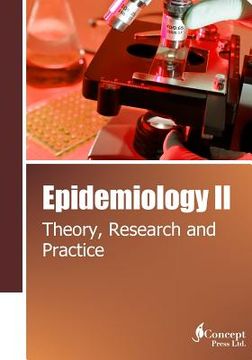Compartir
Epidemiology II: Theory, Research and Practice (en Inglés)
Iconcept Press
(Autor)
·
Iconcept Press
· Tapa Blanda
Epidemiology II: Theory, Research and Practice (en Inglés) - Press, Iconcept
Elige la lista en la que quieres agregar tu producto o crea una nueva lista
✓ Producto agregado correctamente a la lista de deseos.
Ir a Mis Listas
Origen: Estados Unidos
(Costos de importación incluídos en el precio)
Se enviará desde nuestra bodega entre el
Lunes 29 de Julio y el
Lunes 12 de Agosto.
Lo recibirás en cualquier lugar de Argentina entre 1 y 3 días hábiles luego del envío.
Reseña del libro "Epidemiology II: Theory, Research and Practice (en Inglés)"
Epidemiology is the study (or the science of the study) of the patterns, causes, and effects of health and disease conditions in defined populations. Epidemiology has developed into a vibrant scientific discipline that brings together the social and biological sciences, incorporating everything from statistics to the philosophy of science in its aim to study and track the distribution and determinants of health events. Epidemiology II -- Theory, Research and Practice presents the latest epidemiological principles, concepts and research outcomes as well as the practical uses of epidemiology in public health and in clinical practice. Chapter 1 introduces a P3 laboratory. A P3 laboratory allows handling of microorganisms that can be spread through inhalation. The laboratory's structure is constructed using material that is resistant to any form of corrosion. Chapter 2 illustrates the importance of assessing mixtures in drinking water as risk factors for disease, especially when exposure to the mixture can result in a reaction product that is more toxic than the contaminants alone. It reviews nitrosamine metabolism and carcinogenesis as well as provides an assessment of nitrate and atrazine in Nebraska groundwater. In Chapter 3, a linked Surveillance, Epidemiology, and End Results (SEER)-Medicare database analysis was conducted to evaluate treatment patterns, survival, and frequency of complications among elderly patients undergoing treatment for metastatic colorectal cancer (mCRC). The results provide real-world confirmation of clinical trial data in younger patients and imply that age should not discourage the use of guideline-recommended therapies for mCRC. Chapter 4 describes an observational retrospective study concerning the implementation of laparoscopic surgery for rectal cancer within a fast track recovery setting. The clinical and oncological outcomes are analyzed. Chapter 5 explores the use of social quality theory for researching and understanding the social determinants of health. In this chapter, the authors use national data from Australia to analyse the social determinants of health using social quality theory. Chapter 6 discusses the applicability of stopped-flow light scattering analysis as a new methodology for determining stability of the enveloped viruses. It demonstrates how the technique can be used to qualitative and quantitative evaluate the stability of the influenza virus. In Chapter 7, it discusses recent studies revealing that the exchange of genetic information between hosts and pathogens is more frequent and has a larger impact in their genomes than formerly thought, even in previously unsuspected species. This horizontal gene transfer has important implications in the evolution of hosts, pathogens and the relationships between them. Chapter 8 discusses Avian influenza virus (AIV). It can cause a variety of diseases in domesticated poultry ranging from asymptomatic to severe systemic infections with 100% morbidity and mortality. This chapter reviewed in details the chemotherapeutics, natural antivirals and probiotics on AIV. Chapter 9 shows that ecology of Babesia microti group, a tick-bone erythrocytic protozoan, can be elucidated by well-designed epidemiological survey and molecular analysis. Chapter 10 focuses the community-based intervention employing the cluster randomized balanced design and discusses the interconnected links between epidemiological surveillance of dengue vector breeding. Chapter 11 discusses molecular and cell culture methods for evaluating viral contamination in environmental samples. It proposes to indicate the human adenovirus as a model of enteric virus to assess the efficiency of disinfection processes and as a biomarker in sanitary quality studies.
- 0% (0)
- 0% (0)
- 0% (0)
- 0% (0)
- 0% (0)
Todos los libros de nuestro catálogo son Originales.
El libro está escrito en Inglés.
La encuadernación de esta edición es Tapa Blanda.
✓ Producto agregado correctamente al carro, Ir a Pagar.

